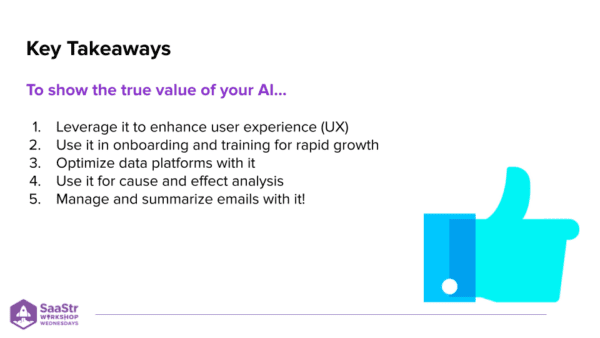People have said “AI” more this year than any other year combined. Everyone is looking forward to what AI can do for them in business.
In a recent Workshop Wednesday, held every Wednesday at 10 a.m. PST, the CIO and SVP of IT at Freshworks, Prasad Ramakrishnan, shares five ways organizations can leverage AI to solve problems and grow.
“Don’t be a solution looking for a problem,” Prasad says. Instead, look for a problem to solve.
We’ve been through big data and tech hype cycles since the early 2000s — when businesses were considered dead if they didn’t have a website, and mobile was everything.
But this AI wave is slightly different. It isn’t new! AI has been around for 30-40 years now. What’s different is the aspect of generative AI. Instead of using AI tools only to analyze and automate things, it’s being used to create content. AI is enabling businesses to do a lot more than they could on human power alone.
So, let’s look at five tips for how you can access the true value of AI.
Tip #1: Leverage AI to Enhance the User Experience (UX)
From an overall value proposition perspective, every company wants to enhance the user experience. They want employees and customers to have the best possible experience.
“User experience” wasn’t a mainstream term 5-6 years ago, and now it’s a primary focus for most companies. Without the users, you have no business. Let’s look at an example.
When someone is asking for support, it can be frustrating to explain your situation over and over to multiple people. An AI-driven virtual agent eliminates that with a roundtrip conversation in a humanizing way.
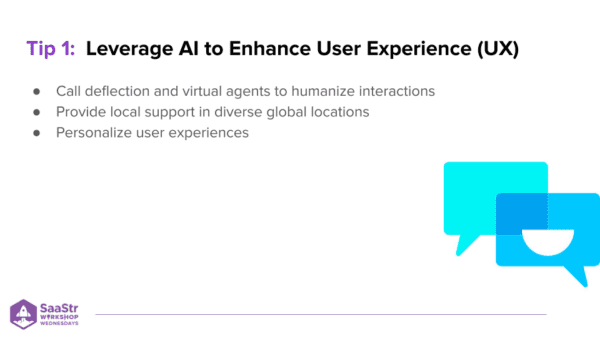
Back in the day, AI was “Press 1 for x. Press 2 for x. Press 0 to speak to an operator.” Everyone pressed zero because no one wanted to talk to a robot. Generative AI changes the game, though, because it provides a more intuitive human experience.
And what about language translation? Many businesses have customers all over the world, and sometimes, they may not speak English. But you still have to be able to serve the needs of customers and employees in different geographic locations. But you can only hire so many translators. There is a linearity factor where you can’t 100x your employee count just because you went from $1M to $100M. Leveraging AI helps you achieve scale while still serving the needs of a broad customer base.
The Takeaways —
You don’t need to add more customer service agents. AI can humanize the experience from an end-user perspective and serve the needs of automating and expanding your reach with personalization.
You can use AI to enhance user experiences through:
- Call deflection and virtual agents to humanize interactions.
- Providing local support in diverse global locations.
- Personalizing user experiences.
Tip #2: Rapidly Scale Across The Globe With AI Onboarding and Training
Imagine bringing a whole bunch of employees into your organization. Typically, when a person comes into your team, you buddy them up with an existing member to show how things are done. If you’re scaling across the globe with a team working remotely and in the office, you won’t always have a buddy to sit next to.
So, how do you train and onboard new employees and make them productive?
By having AI as the onboarding and training co-pilot. For example, if you’re composing an email to a prospect, a person making a buying decision, or even an angry customer, what is this new person to do?
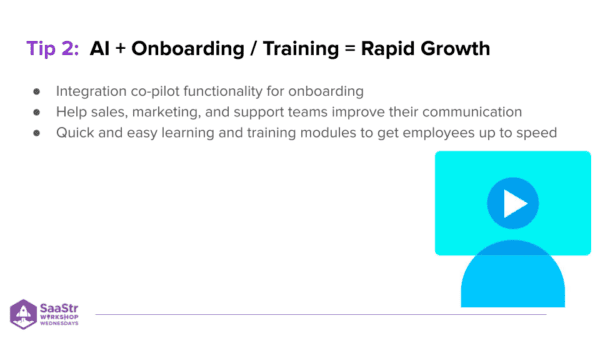
Lean into the AI co-pilot. It can generate a draft based on the context of the ticket, sales deal, marketing program you’re using, etc. Then, you, as the human, can enhance and further personalize and enable the sales engineer to become much more productive.
The Takeaways —
If you’re rapidly scaling and don’t want to scale your employees linearly, AI can play a huge role through:
- Integration of co-pilot functionality for onboarding.
- Helping sales, marketing, and support teams improve their communication.
- Quick and easy learning and training modules to get employees up to speed.
Tip #3: Optimize Data Platforms with AI
We have the ability to bring in large amounts of data, and the cost of processing and storage has dramatically reduced over the past 20 years. But how do you make sense of all of this excessive data from a bunch of different sources?
AI can play a role.
Rather than writing code from multiple structured and unstructured sources, you can tell the AI to write a piece of Python code to bring data from one source or another into your data lake.
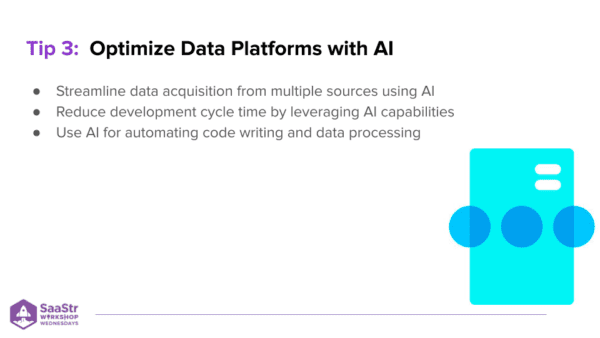
The Takeaway —
AI would give you the starting points of code. It would also allow you to reduce cycle time to value from the point of view of bringing in data and analyzing that data.
Tip #4: AI for Cause and Effect Analysis
Most everyone has a data platform where they bring data from multiple sources and extract insights from it — like average customer satisfaction, deal lifecycle, etc. Let’s say the data shows 80% of your customers are happy, 10% are neutral, and 10% are extremely unhappy.
What would you do?
Focus on that remaining 10% to see why they’re unhappy and, ideally, increase that happiness. This is where AI can be deployed. Not only would it identify the patterns and correlation between the data to bring back these insights, but it would also provide insights into why those customers are unhappy in the first place.
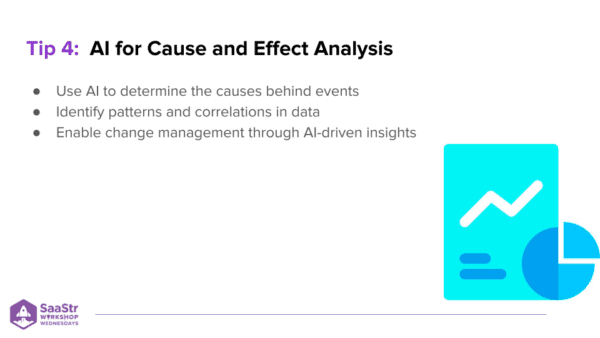
Instead of fishing for this information, AI serves it to you, and now you can make a data-driven decision for your company. This is where the cycle time between the time data is consumed and the time it is analyzed is shortened.
The Takeaway —
Say you learn that there are a lot of returns from a warehouse. With AI, you can identify this issue before it’s too late. You can change where you’re shipping from or solve the issue at the warehouse and save your business from a lot of problems.
AI uses data from many sources and provides insights to save your business time, money, and headache.
Tip #5: Manage and Summarize Emails with AI
Thanks to ChatGPT and GPT4, you can create a lot of content. You can make movies with movie star look-alikes who are actually AI avatars. You can even have AI write entire fiction novels if you want it to.
From an internal business context, you could also use it to summarize emails, support tickets, and meetings.
For example, someone calls for support, and a level 1 agent takes care of it but can’t solve it. So, it goes to level 2 and so on. What happens is the level 1 or 2 person summarizes the issue to the next person, so the new agent doesn’t have to read through 500 chat messages. This is tedious.
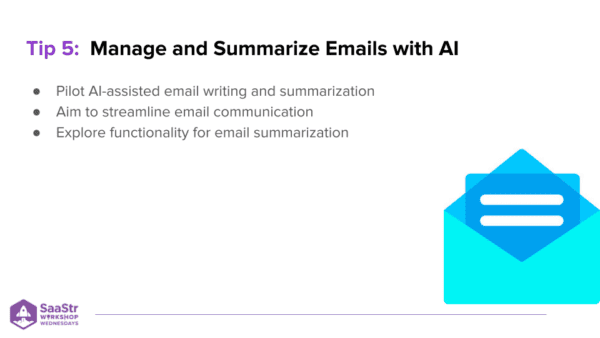
The Takeaway —
AI can help summarize the context of a ticket, emails, meetings, and anything else, drastically reducing the time spent writing, summarizing, and trying to figure out what happened before a situation arises with a support person or salesperson.
Key Takeaways for the True Value of AI
Five ways you can or will be able to leverage AI very soon include:
- To enhance your user experience (UX).
- To seamlessly onboard and train for rapid growth.
- To optimize data platforms.
- For cause and effect analysis.
- To manage and summarize emails.
